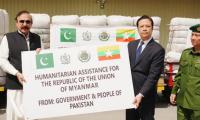The time has come for Pakistan to take some tough decisions and reorient its economic policies. Business as usual will yield the same errors. The shocking economic and human security projections will make the 100 million young people even angrier. Instead of becoming a demographic dividend, the youth are fast turning into a liability. Angry young people, oppressed women, persecuted minorities and the pampered elite constitute the matrix of Pakistan’s political economy and social demography.
Our economy has been badly affected by the elite’s indecision to part with their concessions given by the state, which results in lack of structural reforms in the economy. The country’s politics also lies hostage to dynasties and demagogues. Rule of law and discipline are applied arbitrarily to encourage anarchy in every sphere of national existence. The tendency to brush everything under the carpet has become a national habit, a fact not helped by the proliferation of motivational speakers who specialize in lulling the nation to sleep.
The first steps to improvement are taken only after one agrees that there is a problem. That we will have serious problems if we continue moving on the present trajectory is a fact which has now been empirically proven through forecasts by credible institutions.
If we compare our per capita GDP to other countries in the region like Iran, India, Indonesia, and Bangladesh, we find that their respective GDPs – $2199, $2448, $4680, and $2692 – are significantly greater than our figure of $1596.
According to the IMF and the French Institute for Demographic Studies (INED), Pakistan’s GDP per capita is projected to be $5,263 by 2047 whereas India’s GDP is projected to be $34,423. This means that the current per capita GDP gap of 1.37 per cent between India and Pakistan is expected to grow to over six per cent by the year 2047.
To get out of the vicious circle of debt burden and the perennial balance-of-payments crisis, Pakistan needs to enhance its exports, which, in the last 25 years, have dipped from 16 per cent to 10 per cent of the GDP.
World Bank projections point towards a decline of our manufacturing sector’s share from the current 12.7 per cent to nine per cent in the future, which will scale down our exports volume. The depreciation of Pakistan’s currency by 76 per cent in the last 25 years points towards our chronic balance-of-payment crisis which has constrained our ability to dedicate requisite resources towards health and education.
Pakistan’s current fertility rate of 1.9 is expected to double the youth population by 2025. According to recent UN projections, the total population is expected to reach 366 million by the year 2050. Going by the current imbalance in GDP and population rates, Pakistan’s spending on human security needs to be enhanced, failing which the country’s per capita health and education spending is going to trail far behind its South Asian peers.
The larger question confronting the national leadership is whether the bleak predictions could be reversed without fundamental reforms in our governance and economic management. The answer is a resounding no. And this lets the question of policy changes and resource generation assume top priority. The elite capture of the economy is easily defined through Kuznets tax directory method that points out that the top 10 per cent of the population holds 58.5 per cent of the income share, leaving the bottom 30 per cent with a mere 11.6 per cent. Pakistan’s revenue generation is captive to a weak tax-to-GDP ratio of 10 per cent, compared with an average of 19 per cent for the Asia-Pacific region, and 30 per cent for the OECD countries.
According to the UNDP Report 2021 on Human Development in Pakistan, the annual cost of privileges to elite groups, including the corporate sector, feudal landlords, and the political class, amounts to a whopping $17.4 billion.
To break out of this stranglehold of elite privilege, the political elite needs to forge a national consensus to introduce meaningful reforms in economy and governance. The political, feudal, bureaucratic and business elite will have to let go of the old extractive habits and be prepared to part with several unearned rents.
Pakistan’s economic policies need to alter the economy’s structure to incentivize exports and disincentivize dollar-hungry consumption. Our tax policies should be devised in a way to give breathing space to the industrial and corporate sectors, promoting export oriented growth. According to a World Bank report, Pakistan’s export potential is $88 billion, which could be attained, provided an enabling environment is provided to the industries where Pakistan has a comparative advantage.
Dr Ishrat Husain while writing on the political economy of Pakistan hypothesizes that structural changes in the economy are facilitated when a country’s economy faces collapse. The time has come to confront this reality and overcome the opposition of the interest groups and the rent-seeking elite that is thriving on the present iniquitous and inefficient structure of the economy.
Such structural reforms should be made by dismantling the regime of elite privileges and redirecting the entrepreneurial energies towards the productive sectors of the economy, which may earn the country the much-needed dollars. The provision of basic inputs at affordable rates for industrial revival should be a state priority to make our exports competitive. The tax regime should be broad based and equitable with serious reforms in tax administration.
A stable environment for foreign direct investment is crucial for economic revival along with the availability of the right human capital to facilitate that investment. The reforms process to bring structural reforms should start with the dismantling of privileges, concessions and rent extraction. The nation has two choices before it: reform or perish.
The writer is a security analyst and a PhD scholar. He can be reached at:
rwjanj@hotmail.com
This demand has fueled rapid growth deposit base of Islamic Banks and Islamic Windows operated by conventional banks
But Punjab Agriculture Food and Drug Authority building near Thokar Niazbeg on Multan Road stands out
Macron has been particularly vocal in their criticism, asserting that withholding arms from Kyiv plays directly into...
As PPP governs province, Bilawal Bhutto Zardari holds strategic position to address both violence and its underlying...
Critics argue that strategy is vague, but closer look indicates strategic alignment with global trends and national...
To defeat it, we must distrust bot-driven narratives, to defeat it, we must verify sources before believing or sharing







